JVC KD-G220, KD-AR270 User Manual
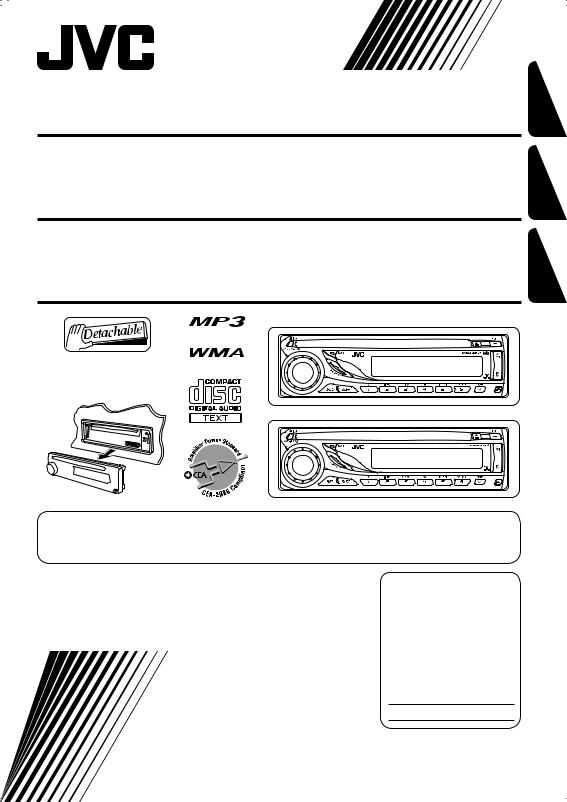
CD RECEIVER
RECEPTOR CON CD
RECEPTEUR CD
KD-AR270/KD-G220
KD-AR270/KD-G220
KD-AR270/KD-G220
KD-AR270
KD-G220
FRANÇAIS ESPAÑOL ENGLISH
For canceling the display demonstration, see page 5.
Para cancelar la demostración en pantalla, consulte la página 5.
Pour annuler la démonstration des affichages, référez-vous à la page 5.
For installation and connections, refer to the separate manual. Para la instalación y las conexiones, refiérase al manual separado.
Pour l’installation et les raccordements, se référer au manuel séparé.
INSTRUCTIONS
MANUAL DE INSTRUCCIONES
MANUEL D’INSTRUCTIONS
For customer Use:
Enter below the Model No. and Serial No. which are located on the top or bottom of the cabinet. Retain this information for future reference.
Model No.
Serial No.
GET0335-001A
[J]

ENGLISH
Thank you for purchasing a JVC product. Please read all instructions carefully before operation, to ensure your complete understanding and to obtain the best possible performance from the unit.
INFORMATION (For U.S.A.)
This equipment has been tested and found to comply with the limits for a Class B digital device, pursuant to Part 15 of the FCC Rules. These limits are designed to provide reasonable protection against harmful interference in a residential installation. This equipment generates, uses, and can radiate radio frequency energy and, if not installed and used in accordance with the instructions, may cause harmful interference to radio communications. However, there
is no guarantee that interference will not occur in a particular installation. If this equipment does cause harmful interference to radio or television reception, which can be determined by turning the equipment off and on, the user is encouraged to try to correct the interference by one or more of the following measures:
–Reorient or relocate the receiving antenna.
–Increase the separation between the equipment and receiver.
–Connect the equipment into an outlet on a circuit different from that to which the receiver is connected.
–Consult the dealer or an experienced radio/ TV technician for help.
Warning:
If you need to operate the unit while driving, be sure to look ahead carefully or you may be involved in a traffic accident.
How to reset your unit
•Your preset adjustments will also be erased.
•If a disc is loaded, it will eject. Be careful not to drop the disc.
How to forcibly eject a disc
•If this does not work, reset your unit.
•Be careful not to drop the disc when it ejects.
 How to use the M MODE button
How to use the M MODE button
If you press M MODE, the unit goes into functions mode, then the number buttons and  ¢/4
¢/4 buttons work as different function buttons.
buttons work as different function buttons.
Ex.: When number button 2 works as MO (monaural) button.
IMPORTANT FOR LASER PRODUCTS
1.CLASS 1 LASER PRODUCT
2.CAUTION: Do not open the top cover. There are no user serviceable parts inside the unit; leave all servicing to qualified service personnel.
3.CAUTION: Visible and invisible laser radiation when open and interlock failed or defeated. Avoid direct exposure to beam.
Time countdown indicator
To use these buttons for their original functions again after pressing M MODE, wait for 5 seconds without pressing any of these buttons until the functions mode is cleared or press M MODE again.
2
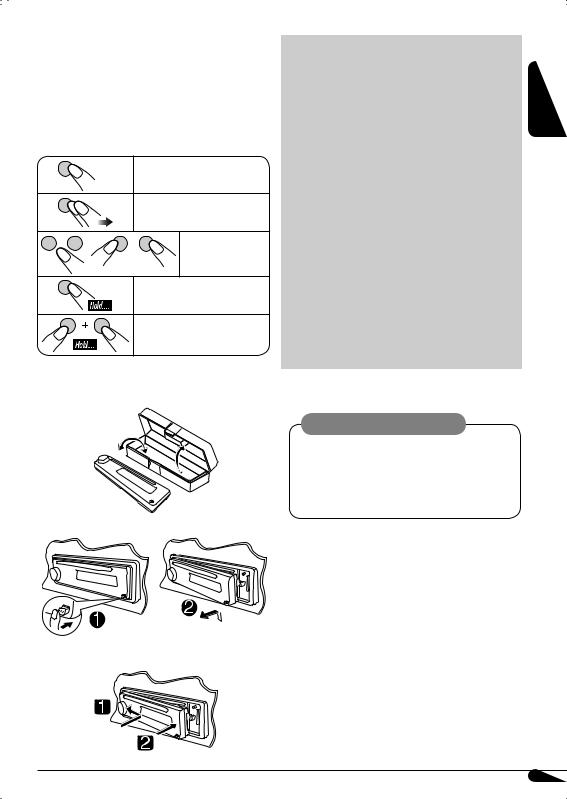
 How to read this manual
How to read this manual
•Button operations are mainly explained with the illustrations in the table below.
• is used to indicate an indicator is displayed for the corresponding operation.
is used to indicate an indicator is displayed for the corresponding operation.
•Some related tips and notes are explained in “More about this unit” (see pages 14 and 15).
Press briefly.
Press repeatedly.
Press either one.
Press and hold until your desired response begins.
Press and hold both buttons at the same time.
 How to detach/attach the control panel
How to detach/attach the control panel
Detaching...
CONTENTS
|
|
|
ENGLISH |
|
Control panel — KD-AR270 and KD-G220 |
4 |
|||
|
||||
Getting started................................. |
5 |
|
||
Basic operations.................................................... |
5 |
|
||
Radio operations .............................. |
6 |
|
||
Disc operations................................. |
7 |
|
||
Playing a disc in the unit ....................................... |
7 |
|
||
Sound adjustments........................... |
9 |
|
||
General settings — PSM ................... |
10 |
|
||
Remote controller — RM-RK60 .............. |
12 |
|
||
Maintenance .................................... |
13 |
|
||
More about this unit ......................... |
14 |
|
||
Troubleshooting............................... |
16 |
|
||
Specifications................................... |
17 |
|
||
Caution on volume setting:
Discs produce very little noise compared with other sources. Lower the volume before playing a disc to avoid damaging the speakers by the sudden increase of the output level.
|
For safety... |
|
• Do not raise the volume level too much, as |
|
this will block outside sounds, making driving |
|
dangerous. |
Attaching... |
• Stop the car before performing any |
complicated operations. |
Temperature inside the car...
If you have parked the car for a long time in hot or cold weather, wait until the temperature in the car becomes normal before operating the unit.
3

ENGLISH
Control panel — KD-AR270 and KD-G220
Parts identification
Display window
1 |
|
|
(standby/on/attenuator) button |
|
|
||
|
|
||
2 |
SOURCE button |
||
3 |
BAND button |
||
4Remote sensor
•You can control this unit with an optionally purchased remote controller. For details, see page 12.
•DO NOT expose the remote sensor to strong light (direct sunlight or artificial
lighting).
5 Loading slot
6 Display window
7 0(eject) button
8 EQ (equalizer) button
9  ¢/4
¢/4 buttons p Control dial
buttons p Control dial
q SEL (select) button w DISP (display) button
e MO (monaural) button
rSSM (Strong-station Sequential Memory) button
t Number buttons y RPT (repeat) button
u RND (random) button i M MODE button
o  (control panel release) button
(control panel release) button
Display window
; Disc information indicators—TAG (ID3 Tag), (folder),
(folder), (track/file)
(track/file)
a Disc type indicators—WMA, MP3 s DISC indicator
dPlayback mode / item indicators— RND (random), (disc),
(disc), (folder),
(folder),
RPT (repeat)
f LOUD (loudness) indicator g EQ (equalizer) indicator
hSound mode (C-EQ: custom equalizer) indicators—JAZZ, CLASSIC, HIP HOP, POPS, ROCK, USER
j Tr (track) indicator
kSource display / Volume level indicator / Time countdown indicator
l Main display
/Tuner reception indicators— ST (stereo), MO (monaural)
4
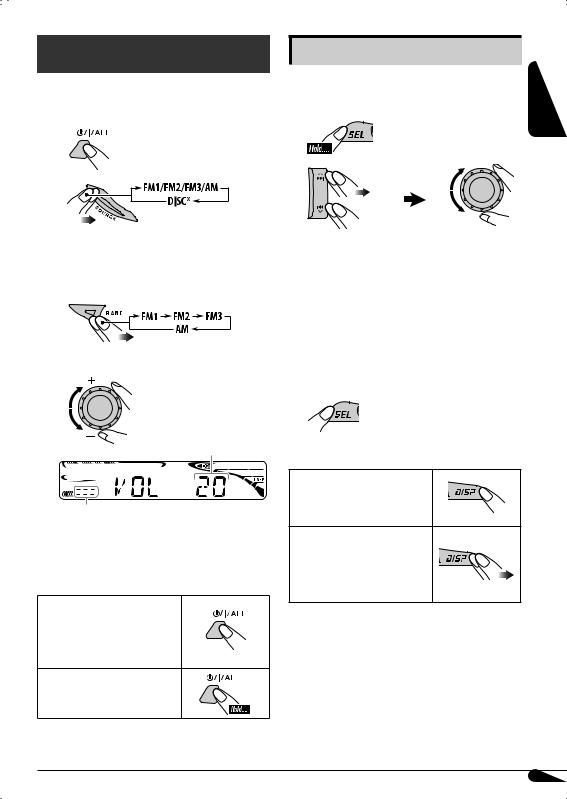
Getting started
Basic operations 
~ Turn on the power.
Ÿ
*You cannot select “DISC” as the playback source if there is no disc in the unit.
!For FM/AM tuner
⁄ Adjust the volume.
Volume level appears.
Basic settings
•See also “General settings — PSM” on pages 10 and 11.
1
2
1 Canceling the display demonstrations
Select “DEMO,” then “DEMO OFF.”
2Setting the clock
Select “CLOCK H” (hour), then adjust the hour.
Select “CLOCK M” (minute), then adjust the minute.
3 Finish the procedure.
Volume level indicator
@Adjust the sound as you want. (See page 9.)
To drop the volume in a moment (ATT)
To restore the sound, press it again.
To turn off the power
To check the current clock time while the power is turned off
To check the other information while listening to the radio
Clock ÔFrequency
ENGLISH
5
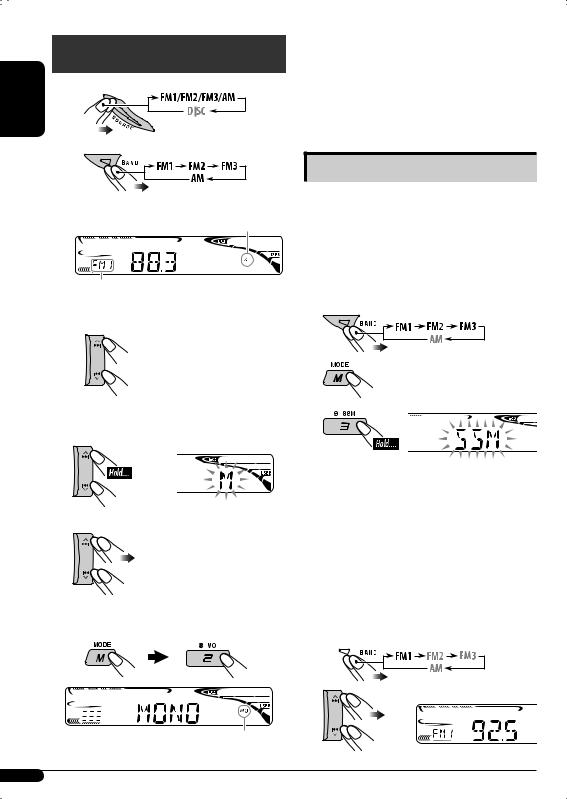
Radio operations
ENGLISH |
~ |
|
|
|
Ÿ |
|
Lights up when receiving an FM stereo |
|
broadcast with sufficient signal strength. |
Selected band appears.
! Start searching for a station.
When a station is received, searching stops.
To stop searching, press the same button again.
To tune in to a station manually
In step ! above...
1
2 Select the desired station frequencies.
When an FM stereo broadcast is hard to receive
Lights up when monaural mode is activated.
Reception improves, but stereo effect will be lost.
To restore the stereo effect, repeat the same procedure. “MONO OFF” appears and the MO indicator goes off.
Storing stations in memory
You can preset six stations for each band.
 FM station automatic presetting— SSM (Strong-station Sequential Memory)
FM station automatic presetting— SSM (Strong-station Sequential Memory)
1Select the FM band (FM1 – FM3) you want to store into.
2
3
“SSM” flashes, then disappears when automatic presetting is over.
Local FM stations with the strongest signals are searched and stored automatically in the FM band.
 Manual presetting
Manual presetting
Ex.: Storing FM station of 92.5 MHz into preset number 4 of the FM1 band.
1 
2
6
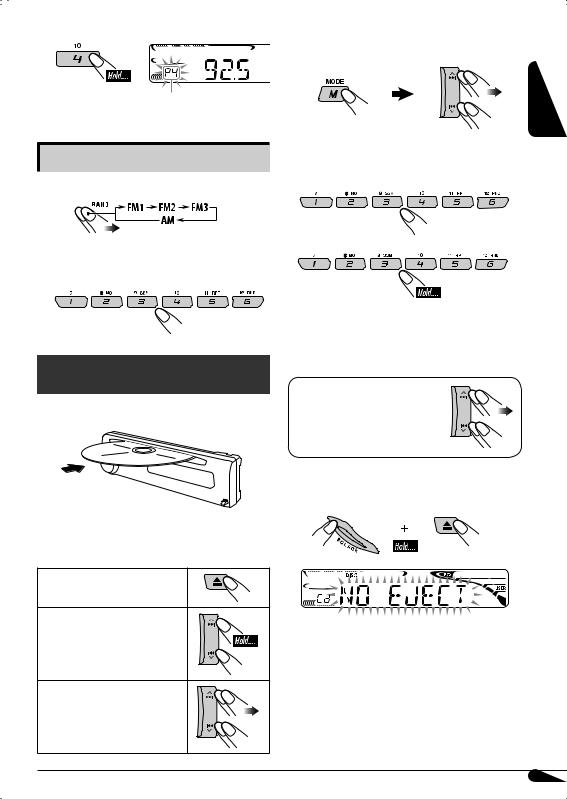
3
Preset number flashes for a while.
Listening to a preset station
1 
2Select the preset station (1 – 6) you want.
To go to the next or previous folders (only for MP3 or WMA discs)
ENGLISH
To locate a particular track (for CD) or folder (for MP3 or WMA discs) directly
To select a number from 01 – 06:
To select a number from 07 – 12:
Disc operations
Playing a disc in the unit 
All tracks will be played repeatedly until you change the source or eject the disc.
•To use direct folder access on MP3/WMA discs, it is required that folders are assigned with 2-digit numbers at the beginning of their folder names—01, 02, 03, and so on.
To select a particular track in a folder (for MP3 or WMA disc):
 Prohibiting disc ejection
Prohibiting disc ejection
You can lock a disc in the loading slot.
To stop play and eject the disc
To fast-forward or reverse the track
To go to the next or previous tracks
To cancel the prohibition, repeat the same procedure.
7

ENGLISH
Changing the display information |
Selecting the playback modes |
|
You can use only one of the following playback |
|
modes at a time. |
While playing an audio CD or a CD Text |
1 |
|
2 Select your desired playback mode. |
 While playing an MP3 or a WMA disc
While playing an MP3 or a WMA disc
•When “TAG DISP” is set to “TAG ON” (see page 11)
7 Repeat play
Mode Plays repeatedly
TRK RPT : The current track.  FLDR RPT*3 : All tracks of the current
FLDR RPT*3 : All tracks of the current
folder. 

 RPT OFF : Cancels.
RPT OFF : Cancels.
• When “TAG DISP” is set to “TAG OFF” |
7 Random play |
||||||||
|
|
|
|
|
|
|
|
|
|
|
|
|
|
|
|
|
|
|
|
|
|
|
|
|
|
|
|
|
|
|
|
|
|
|
|
|
|
|
|
|
|
|
|
|
|
|
|
|
|


 : Clock with the current track number
: Clock with the current track number
: Elapsed playing time with the current track number
*1 If the current disc is an audio CD, “NO NAME” appears.
*2 If an MP3/WMA file does not have ID3 tags, folder name and file name appear. In this case, the TAG indicator will not light up.
Mode |
Plays at random |
FLDR RND*3 : All tracks of the current folder, then tracks of the next folder and so on. 
DISC RND : All tracks of the current disc.
RND OFF : Cancels.
*3 Only while playing an MP3 or a WMA disc.
8
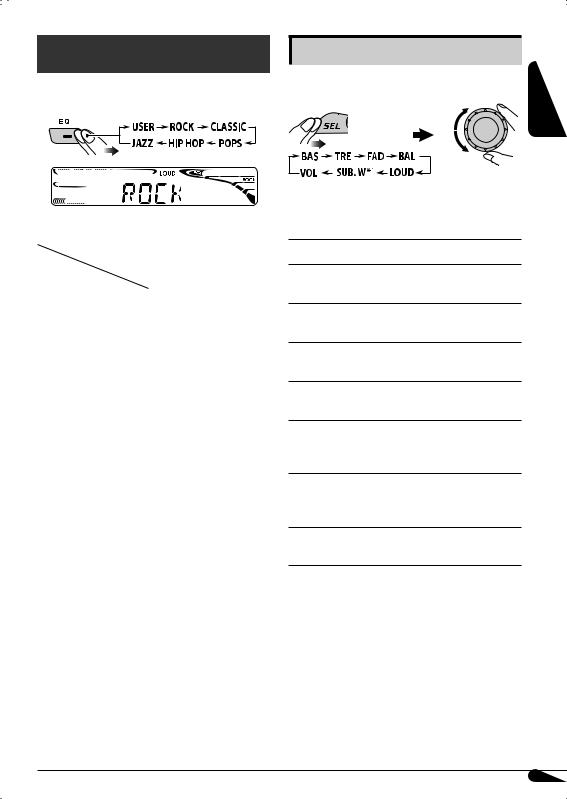
Sound adjustments
You can select a preset sound mode suitable to the music genre (C-EQ: custom equalizer).
Ex.: When “ROCK” is selected
Preset values |
BAS |
TRE |
LOUD |
|
|
||||
Indication (For) |
(bass) |
(treble) |
(loudness) |
|
|
|
|
||
USER |
00 |
00 |
OFF |
|
(Flat sound) |
||||
|
|
|
||
|
|
|
|
|
ROCK |
+03 |
+01 |
ON |
|
(Rock or disco music) |
||||
|
|
|
||
|
|
|
|
|
CLASSIC |
+01 |
–02 |
OFF |
|
(Classical music) |
||||
|
|
|
||
|
|
|
|
|
POPS |
+04 |
+01 |
OFF |
|
(Light music) |
||||
|
|
|
||
|
|
|
|
|
HIP HOP |
+02 |
00 |
ON |
|
(Funk or rap music) |
||||
|
|
|
||
|
|
|
|
|
JAZZ |
+02 |
+03 |
OFF |
|
(Jazz music) |
||||
|
|
|
||
|
|
|
|
Adjusting the sound
You can adjust the sound characteristics to your preference.
*1 Displayed only when “L/O MODE” is set to “WOOFER” (see page 11).
Indication, [Range]
BAS*2 (bass), [–06 to +06]
Adjust the bass.
TRE*2 (treble), [–06 to +06]
Adjust the treble.
FAD*3 (fader), [R06 to F06]
Adjust the front and rear speaker balance.
BAL*4 (balance), [L06 to R06]
Adjust the left and right speaker balance.
LOUD*2 (loudness), [LOUD ON or LOUD OFF] Boost low and high frequencies to produce a well-balanced sound at low volume level.
SUB. W*5 (subwoofer), [00 to 08]
Adjust the subwoofer output level when a subwoofer is connected.
VOL (volume), [00 to 30 or 50*6]
Adjust the volume.
*2 When you adjust the bass, treble, or loudness, the adjustment you have made is stored for the currently selected sound mode (C-EQ) including “USER.”
*3 If you are using a two-speaker system, set the fader level to “00.”
*4 This adjustment cannot affect the subwoofer output.
*5 This takes effect only when a subwoofer is connected.
*6 Depending on the amplifier gain control setting. (See page 11 for details.)
ENGLISH
9
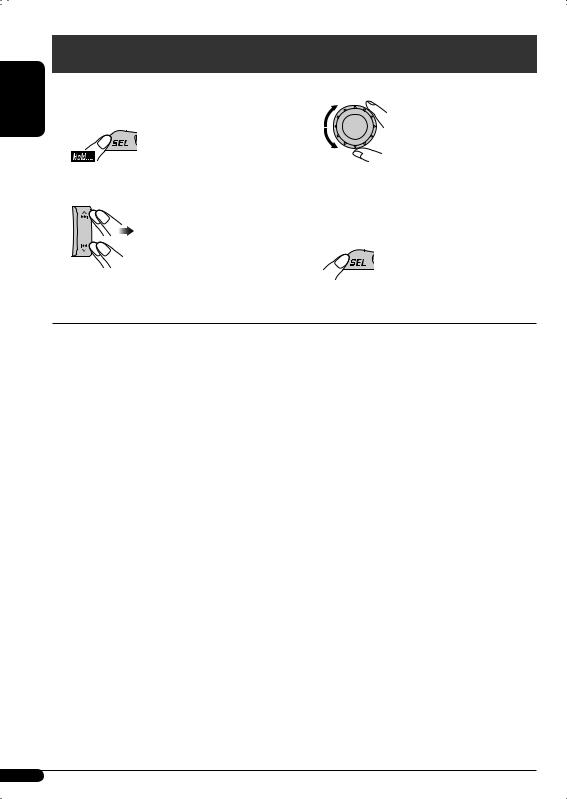
ENGLISH
General settings — PSM
You can change PSM (Preferred Setting Mode) |
3 Adjust the PSM item selected. |
items listed in the table that follows. |
|
1 |
|
2 |
4 |
Repeat steps 2 and 3 to adjust other |
Select a PSM item. |
PSM items if necessary. |
|
|
5 |
Finish the procedure. |
Indications |
Selectable settings, [reference page] |
||
DEMO |
DEMO ON : [Initial]; Display demonstration will be activated |
||
|
Display |
|
automatically if no operation is done for about 20 seconds, |
|
demonstration |
|
[5]. |
|
|
DEMO OFF : Cancels. |
|
|
|
|
|
CLOCK H |
1 – 12, [5] |
|
|
|
Hour adjustment |
[Initial: 1 (1:00)] |
|
|
|
|
|
CLOCK M |
00 – 59, [5] |
|
|
|
Minute adjustment |
[Initial: 00 (1:00)] |
|
|
|
|
|
DIMMER |
ON |
: Dims the display illumination of this unit. |
|
|
Dimmer |
OFF |
: [Initial]; Cancels. |
|
|
|
|
SCROLL*1 |
ONCE |
: [Initial]; Scrolls the disc information once. |
|
|
Scroll |
AUTO |
: Repeats scrolling (5-second intervals in between). |
|
|
OFF |
: Cancels. |
|
|
• Pressing DISP for more than one second can scroll the display regardless |
|
|
|
of the setting. |
|
|
|
|
|
WOOFER*2 |
LOW |
: Frequencies lower than 55 Hz are sent to the subwoofer. |
|
|
Subwoofer cutoff |
MID |
: [Initial]; Frequencies lower than 85 Hz are sent to the |
|
frequency |
|
subwoofer. |
|
|
HIGH |
: Frequencies lower than 115 Hz are sent to the subwoofer. |
|
|
||
*1 |
Some characters or symbols will not be shown correctly (or will be blanked) on the display. |
||
*2 |
Displayed only when “L/O MODE” is set to “WOOFER.” |
||
10

Indications |
Selectable settings, [reference page] |
|
L/O MODE |
When connecting an amplifier or a subwoofer, set this correctly. |
|
Line output mode |
REAR |
: [Initial]; Select if the REAR LINE OUT terminals are used |
|
|
for connecting the speakers through an external amplifier. |
|
WOOFER |
: Select if the REAR LINE OUT terminals are used for |
|
|
connecting a subwoofer. |
|
|
|
TAG DISP |
TAG ON |
: [Initial]; Shows the ID3 tag while playing MP3/WMA tracks, |
Tag display |
|
[8]. |
|
TAG OFF |
: Cancels. |
|
|
|
AMP GAIN |
You can change the maximum volume level of this unit. |
|
Amplifier gain |
LOW PWR : VOL 00 – VOL 30 (Select this if the maximum power of the |
|
control |
|
speaker is less than 50 W—for KD-AR270 or 45 W—for |
|
|
KD-G220 to avoid damaging the speaker.) |
|
HIGH PWR : [Initial]; VOL 00 – VOL 50 |
|
|
|
|
AREA |
AREA US |
: [Initial]; Select this when using the unit in North or South |
Tuner channel |
|
America, except Middle South America. (FM: 200 kHz; |
interval |
|
AM: 10 kHz) |
|
AREA EU |
: Select this when using the unit in any other area than North, |
|
|
Middle South, and South America. (FM: 50 kHz—manual |
|
|
tuning, 100 kHz—auto search; AM: 9 kHz) |
|
AREA SA |
: Select this when using the unit in Middle South America. |
|
|
(FM: 100 kHz; AM: 10 kHz) |
|
|
|
ENGLISH
11

Remote controller — RM-RK60
ENGLISH |
This unit can be remotely controlled as |
|
|
||
|
instructed here (with an optionally purchased |
|
|
remote controller). We recommend that you |
|
|
use remote controller RM-RK60 with your unit. |
|
|
|
Installing the lithium coin battery |
|
|
|
|
|
|
|
|
(CR2025) |
Aim the remote controller directly at the remote sensor on the unit. Make sure there is no obstacle in between.
Warning:
•Do not install any battery other than CR2025 or its equivalent; otherwise, it may explode.
•Store the battery in a place where children cannot reach to avoid risk of accident.
•To prevent the battery from over-heating, cracking, or starting a fire:
–Do not recharge, short, disassemble, heat the battery, or dispose of it in a fire.
–Do not leave the battery with other metallic materials.
–Do not poke the battery with tweezers or similar tools.
–Wrap the battery with tape and insulate when throwing away or saving it.
Main elements and features
1 

 (standby/on attenuator) button
(standby/on attenuator) button
•Turns the power on if pressed briefly or attenuates the sound when the power is turned on.
•Turns the power off if pressed and held. 2 SRC (source) button
•Selects the source.
3R (reverse) / F (forward) buttons
•Searches for stations if pressed briefly.
•Fast-forwards or reverses the track if pressed and held.
•Changes the tracks of the disc if pressed
briefly.
4 SOUND button
•Selects the sound mode (C-EQ: custom equalizer).
5U (up) / D (down) buttons
•Changes the FM/AM bands with U only.
•Changes the preset stations with D only.
•Changes the folder of the MP3/WMA discs.
6VOLUME – /+ buttons
• Adjusts the volume level.
Caution:
12
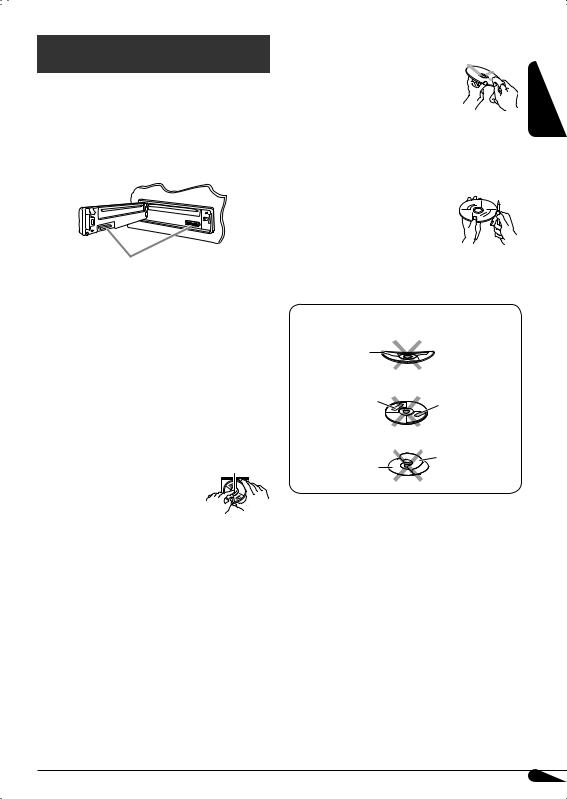
Maintenance
 How to clean the connectors
How to clean the connectors
Frequent detachment will deteriorate the connectors. To minimize this possibility, periodically wipe the connectors with a cotton swab or cloth moistened with alcohol, being careful not to damage the connectors.
Connector
 Moisture condensation
Moisture condensation
Moisture may condense on the lens inside the CD player in the following cases:
•After starting the heater in the car.
•If it becomes very humid inside the car. Should this occur, the CD player may malfunction. In this case, eject the disc and leave the unit turned on for a few hours until the moisture evaporates.
 To keep discs clean
To keep discs clean
A dirty disc may not play correctly. If a disc does become dirty, wipe it with a soft cloth in a straight line from center to edge.
•Do not use any solvent (for example, conventional record cleaner, spray, thinner, benzine, etc.) to clean discs.
 To play new discs
To play new discs
New discs may have some rough spots around the inner and outer edges. If such a disc is used, this unit may reject the disc.
To remove these rough spots, rub the edges with a pencil or ball-point pen, etc.
Do not use the following discs:
Warped disc
Sticker |
Sticker residue |
|
 How to handle discs
How to handle discs
When removing a disc from |
Center holder |
Stick-on label |
|
Disc |
|||
its case, press down the center |
|
||
|
|
||
holder of the case and lift the disc |
|
|
|
out, holding it by the edges. |
|
|
|
• Always hold the disc by the |
|
|
|
edges. Do not touch its recording surface. |
|
||
When storing a disc into its case, gently insert |
|
||
the disc around the center holder (with the |
|
||
printed surface facing up). |
|
|
|
•Make sure to store discs into the cases after use.
ENGLISH
13

More about this unit
ENGLISH |
Basic operations |
|
|
|
|
|
|
|
|
Turning on the power |
|
|
• By pressing SOURCE on the unit, you can |
|
|
also turn on the power. If the source is ready, |
|
|
playback also starts. |
|
Turning off the power
•If you turn off the power while listening to a disc, disc play will start from where playback has been stopped previously, next time you turn on the power.
Selecting the sources
•When no disc is loaded in the unit, “DISC” cannot be selected.
Tuner operations 
Storing stations in memory
•During SSM search...
–All previously stored stations are erased and stations are stored newly.
–Received stations are preset in No. 1 (lowest frequency) to No. 6 (highest frequency).
–When SSM is over, the station stored in No. 1 will be automatically tuned in.
•When storing a station manually, the previously preset station is erased when a new station is stored in the same preset number.
Disc operations 
Caution for DualDisc playback
•The Non-DVD side of a “DualDisc” does not comply with the “Compact Disc Digital Audio” standard. Therefore, the use of NonDVD side of a DualDisc on this product may not be recommended.
General
•This unit has been designed to reproduce CDs/CD Texts, and CD-Rs (Recordable)/ CD-RWs (Rewritable) in audio CD (CD-DA), MP3 and WMA formats.
•When a disc has been loaded, selecting “DISC” for the playback source starts disc play.
Inserting a disc
•When a disc is inserted upside down, the disc automatically ejects.
•Do not insert 8 cm discs (single CD) and unusual shape discs (heart, flower, etc.) into the loading slot.
Playing a disc
•While fast-forwarding or reversing on an MP3 or WMA disc, you can only hear intermittent sounds.
Playing a CD-R or CD-RW
•Use only “finalized” CD-Rs or CD-RWs.
•This unit can play back only files of the same type which are first detected if a disc includes both audio CD (CD-DA) files and MP3/ WMA files.
•This unit can play back multi-session discs; however, unclosed sessions will be skipped while playing.
•Some CD-Rs or CD-RWs may not play back on this unit because of their disc characteristics, or for the following reasons:
–Discs are dirty or scratched.
–Moisture condensation occurs on the lens inside the unit.
–The pickup lens inside the unit is dirty.
–CD-R/CD-RW on which the files are written with “Packet Write” method.
–There are improper recording conditions (missing data, etc.) or media conditions (stained, scratched, warped, etc.).
•CD-RWs may require a longer readout time since the reflectance of CD-RWs is lower than that of regular CDs.
14

•Do not use the following CD-Rs or CD-RWs:
–Discs with stickers, labels, or protective seal stuck to the surface.
–Discs on which labels can be directly printed by an ink jet printer.
Using these discs under high temperatures or high humidities may cause malfunctions or damage to the unit.
Playing an MP3/WMA disc
•This unit can play back MP3/WMA files with the extension code <.mp3> or <.wma> (regardless of the letter case—upper/lower).
•This unit can show the names of albums, artists (performer), and ID3 Tag (Version 1.0, 1.1, 2.2, 2.3, or 2.4) for MP3 files and for WMA files.
•This unit can display only one-byte characters. No other characters can be correctly displayed.
•This unit can play back MP3/WMA files meeting the conditions below:
–Bit rate: 8 kbps — 320 kbps
–Sampling frequency:
48 kHz, 44.1 kHz, 32 kHz (for MPEG-1) 24 kHz, 22.05 kHz, 16 kHz (for MPEG-2)
–Disc format: ISO 9660 Level 1/ Level 2, Romeo, Joliet, Windows long file name
•The maximum number of characters for file/ folder names vary among the disc format used (includes 4 extension characters—<.mp3> or <.wma>).
–ISO 9660 Level 1: up to 12 characters
–ISO 9660 Level 2: up to 31 characters
–Romeo: up to 128 characters
–Joliet: up to 64 characters
–Windows long file name: up to 128 characters
•This unit can play back files recorded in VBR (variable bit rate).
Files recorded in VBR have a discrepancy in elapsed time display, and do not show the actual elapsed time. Especially, after performing the search function, this difference becomes noticeable.
• This unit can recognize a total of 512 files, of |
|
|
200 folders, and of 8 hierarchies. |
|
|
• This unit cannot play back the following files: |
ENGLISH |
|
– MP3 files encoded with MP3i and |
||
|
||
MP3 PRO format. |
|
|
– MP3 files encoded in an unappropriate |
|
|
format. |
|
|
– MP3 files encoded with Layer 1/2. |
|
|
– WMA files encoded with lossless, |
|
|
professional, and voice format. |
|
|
– WMA files which are not based upon |
|
|
Windows Media® Audio. |
|
|
– WMA files copy-protected with DRM. |
|
|
– Files which have the data such as WAVE, |
|
|
ATRAC3, etc. |
|
|
• The search function works but search speed is |
|
|
not constant. |
|
Changing the source
•If you change the source, playback also stops (without ejecting the disc).
Next time you select “DISC” for the playback source, disc play starts from where it has been stopped previously.
Ejecting a disc
•If the ejected disc is not removed within
15 seconds, the disc is automatically inserted again into the loading slot to protect it from dust. (Disc will not play this time.)
General settings—PSM 
•If you change the “AMP GAIN” setting from “HIGH PWR” to “LOW PWR” while the volume level is set higher than “VOL 30,” the unit automatically changes the volume level to “VOL 30.”
15
